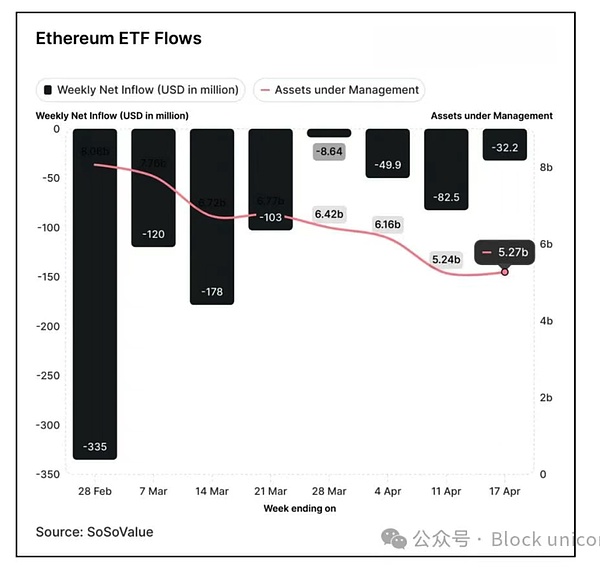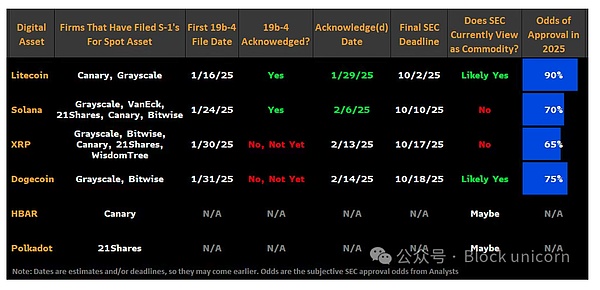Foreword
When Paul Atkins was sworn in as the 34th Chairman of the U.S. Securities and Exchange Commission (SEC) last week, he inherited the heaviest cryptocurrency-related workload in the SEC’s history: more than 70 cryptocurrency exchange-traded fund (ETF) applications awaiting review.
Just three days into his tenure, Atkins faced his first few major crypto decisions. He delayed rulings on multiple ETF proposals until June.
These delays are not unexpected. However, they highlight the daunting task facing the new crypto-friendly Chairman.
Interestingly, funds tracking the second-largest cryptocurrency, Ethereum, are losing money at an alarming rate, even as the altcoin ETF craze takes off.
Despite this, fund companies are still racing to apply for various ETFs. From established altcoins like Solana and XRP to meme coins like Dogecoin, Penguin, and even Trumpcoin, Atkins' work faces many challenges
The contrast raises an intriguing question: Given that Ethereum's experience provides such a troubling precedent, why are altcoins still racing to apply for ETFs?
ETF applications are piling up
Asset management companies have filed ETF applications for at least 15 cryptocurrencies other than Bitcoin and Ethereum.
Grayscale alone has applied for funds tracking Solana, Cardano, XRP, Dogecoin, Litecoin, and Avalanche. Bitwise is hoping to get ETFs approved based on Dogecoin and Aptos, while Canary Capital has been particularly aggressive, submitting applications for Hedera, Penguin, Sui, and most recently a staking-based TRX (Tron) product that even includes yield-generating features.
First, a basic question: Why apply for an ETF?
Bloomberg ETF analyst Eric Balchunas recently posted: "ETF-ing your crypto is like a band putting their songs on all the music streaming services. It doesn't guarantee anyone will listen, but it gets your music in front of the vast majority of listeners."
In simple terms, this means better accessibility for investors and broader adoption through fund companies.
The implications of this issue extend beyond the cryptocurrency space to the complexities of politics. And we're talking about complexities involving U.S. President Donald Trump.
Trump's Media and Technology Group recently announced plans to invest up to $250 million in cryptocurrency-related ETFs.
The Ethereum ETF Dilemma
The timing of these filings is particularly puzzling, as they come at a time when Ethereum ETFs are experiencing a crisis of investor confidence.
As of April 18, Ethereum ETFs have seen outflows for seven consecutive weeks, totaling more than $1.1 billion. As of April 11, assets under management plummeted to $5.24 billion, a record low since these products were launched in July 2024.
The struggle stands in stark contrast to the Bitcoin ETF, which saw nearly $1 billion in inflows each of Thursday and Friday last week, despite market volatility, helping the price of Bitcoin recover to $95,000.
For altcoin investors looking to get in on an Ethereum ETF, the Ethereum ETF’s experience raises an unsettling question: If the second-largest cryptocurrency by market cap can’t sustain investor interest in an ETF wrapper, is there hope for less-established tokens?
Lessons from Ethereum
Beyond the numbers, the Ethereum ETF story involves some fundamental issues that investors in altcoin ETFs must seriously consider if they want to avoid the same fate.
The first is the fee structure, with Grayscale's ETHE being a prime example. Its 2.5% annual fee is clearly unsustainable when competitors like BlackRock offer similar investment opportunities at one-tenth the price.
This fee differential creates a mathematical inevitability - over time, high-fee products will far underperform low-fee products tracking the same asset. This is critical for investors who plan to hold for many years.
The second is Ethereum's increasingly complex value narrative. While Bitcoin benefits from its straightforward “digital gold” positioning, Ethereum’s value proposition encompasses a smart contract platform, a settlement layer for DeFi, an NFT market pillar, and a potential asset that generates yield through staking — a feature that current Ethereum ETFs lack.
This complexity creates a marketing challenge. When financial advisors can’t easily explain investment rationales to clients in a sentence or two, adoption suffers. Bitcoin’s simplicity easily wins this battle.
The third issue is the SEC’s cautious approach to staking. By prohibiting Ethereum ETFs from incorporating staking yield, the regulator has deprived them of a differentiating feature. . The contrast became particularly stark when Canary Capital recently filed for a staking-based TRX ETF, suggesting that some issuers are already trying to overcome this limitation.
Why still betting on ETFs?
Despite the worrying performance of the Ethereum ETF, the rush of altcoin ETF applications has not slowed down. This apparent paradox is driven by several powerful factors that outweigh the immediate concerns raised by Ethereum’s plight.
The most important catalyst is the “Atkins effect.” The appointment of Paul Atkins marks a dramatic shift from Gary Gensler’s tenure, which was viewed by the crypto industry as a period of regulatory hostility.
With his reputation for supporting innovation and history of favoring market-driven solutions, Atkins offers issuers an unprecedented opportunity: a viable path to approval.
The data supports this optimism.
Analysts at Bloomberg estimate that assets like Solana, Litecoin, and XRP have a 75-90% probability of approval.
Atkins' leadership effectively opened a regulatory window that asset managers are racing to take advantage of before it potentially closes.
Institutional demand provides another compelling reason for the ETF rush. According to a March 2025 report from Coinbase and EY-Parthenon, about 83% of institutional investors plan to increase their cryptocurrency allocations this year, with many aiming to put more than 5% of their assets under management into them.
Each altcoin offers a differentiated value proposition that may resonate better than Ethereum’s convoluted narrative.
Solana’s ultra-fast transactions and growing DeFi ecosystem offer a clear efficiency story. XRP’s focus on cross-border payments offers a concrete use case that’s easier to explain to institutional investors. Hedera’s enterprise adoption gives it corporate credibility that pure retail cryptocurrencies lack.
The growth potential of smaller-cap cryptocurrencies also makes a compelling case for ETF issuers.
While Bitcoin and Ethereum may offer stability, their trillion-dollar market caps limit upside. If mid-cap altcoins gain mainstream adoption, they could deliver more significant returns, appealing to growth-oriented investors who missed out on Bitcoin’s early gains.
Potential Market Impact
The most immediate impact will be on capital flows. JPMorgan analysts predict that the Solana ETF alone could attract $3-6 billion in its first year, and XRP could attract $4-8 billion. These flows could significantly impact token prices and market dynamics.
By comparison, the entire spot Ethereum ETF market currently holds about $5.27 billion in assets. If two or three major altcoin ETFs meet these forecasts, they could collectively surpass the Ethereum ETF in size within a few months of launch, creating a significant market recalibration.
However, institutional capital spread across multiple cryptocurrency ETFs also carries the risk of asset dilution.
This could spread the interests of institutional investors across multiple products. Such a surge could result in all altcoin ETFs failing to reach a critical mass of assets under management, making them less attractive to institutional portfolios.
For retail investors, the impact is twofold. On one hand, ETFs offer regulated, secure exposure to cryptocurrencies without the challenges of self-custody. On the other hand, the growing premium paid by ETF investors (through management fees and potential tracking error) means their investment returns may continue to be lower than direct holders of the underlying assets.
If a large number of altcoins are locked up in ETFs, it could reduce the circulating supply and potentially increase volatility in the underlying spot market.
Our Take
The gold rush for altcoin ETFs as Ethereum struggles reveals the power of narrative over performance. Everyone is obsessed with the irony of people flocking to Ethereum, one of the pioneers, while it is losing money. Instead of replicating the Ethereum ETF, they need to focus on leveraging its failure.
Smart issuers are already plotting a different course.
Canary Capital’s staking TRX application is the clearest evidence of this strategic shift. By introducing staking yields — something that Ethereum ETFs lack — they are addressing the core structural flaws that have led to the exodus of Ethereum over the past few weeks.
The “Atkins Effect” simply provided the opportunity.
The catalyst was the realization that Ethereum ETFs failed not because they were ETFs, but because they were not a substitute for native Ethereum. When investors compared ETHE’s 2.5% fees and zero staking yields to simply holding Ethereum, the decision became mathematically obvious.
Analysts’ predictions for altcoin ETFs suggest that this is more than blind optimism. These predictions suggest that specific altcoins with clearer value propositions can succeed where Ethereum’s complex narrative fails.
The ultimate big winners may be the small-cap coins with the most room to grow. The trillion-dollar valuations of Bitcoin and Ethereum limit their upside potential, but a well-targeted altcoin ETF could provide the growth multiples that institutional investors crave.
Rather than a cautionary tale, the Ethereum ETF could be a sacrificial precursor that paves the way for a more successful second wave. Today’s Ethereum ETF failures won’t prove that crypto ETFs don’t work; rather, they will be necessary market feedback to make the next generation work better.
 Brian
Brian









